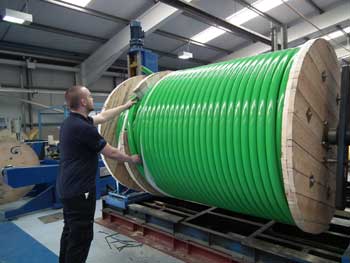Hydro Group: Exploring the Subsea Cable Market

Thanks to the low oil price, the subsea sector is enduring a challenging period. Operators are being forced to venture into more remote and harsher locations, requiring top tier equipment to meet demanding and dynamic environments.
Systems being deployed require reliable power and communications connections suited to meet these demands. Today, the team at Hydro Group are being asked more and more for increasingly complex composite and physically demanding cable designs, the days have gone when the company was simply asked to provide an underwater electrical connection.
As subsea equipment is becoming more complex with data management and collection systems transferring significantly higher volumes of information at faster rates the Transmission Characteristics, Low Loss and Shielding requirements need to be addressed in the design and composition of the cables.
To ensure the performance of the designs, increasing use of complex software modelling and analysis tools are employed. Hydro Group engineers routinely utilise packages such as Comsol multiphysics software to model designs and provide virtual realisation of the cable characteristics under a variety of simulated conditions. Transmission characteristics and performance are also simulated with the use of Optem software tools.
Hydro Group regularly incorporates stainless steel tubes, rather than PBT tubes, for all Subsea Cable designs incorporating fibre optics. The benefits of utilising optical fibres contained within stainless steel tubes are primarily two fold –
Both of these advantages over PBT Tubed fibre optics are deemed crucial in the demanding conditions seen by subsea optical cables.
Mechanical factors are extremely significant in the overall performance of subsea cable designs. Often these present a much higher risk in the reliability and durability of the design than all other constraints. The application of FEA design and modelling tools such as Comsol and Orcaflex allow simulation and analysis of the design to ensure construction and incorporation of components that will meet the dynamic application requirements.
The combination of the above design factors and the fact that equipment demands are increasing rapidly is driving more customised solutions. In addition to the design approach employed and increased testing capabilities, Hydro Group has invested heavily in new machinery, significantly increasing and improving in-house cable manufacturing capabilities, to compliment this rapidly evolving market.
At the start of 2015, the company installed and commissioned an advanced armouring line, extending its product line providing the company with armouring expertise, offering custom-designed single and multi-layered steel armoured cables in galvanised improved steel and corrosion resistant steels.
The new machinery allows the team to manufacture mechanically protected cables to improve and support subsea operations, which can withstand higher stresses in subsea and defence operations. As well as contra helical armoured subsea control cables, which act to neutralise the tension and compression forces that occur in the wires each time the cable is bent or flexed.
With a full appreciation of all electrical, optical, mechanical and environmental requirements imposed on the application of the cable a robust and reliable cabling solution can be realised.
The bundled hoses, which are available in ¼” to 2” size from Hydro Cable Systems, a Hydro Group company, integrate hydraulic components with electrical and fibre optic cables, resulting in a more compact and easier to handle assembly.
This new capability allows the company to extrude up to 120mm diameter over composite bundles or single hoses. Final produced lengths can be supplied from 50 to 2000 metres depending on the size of hose, number of components and the finished diameter of the umbilical.
Hydro Group has seen significant investment in equipment, facilities and training, enabling the company to expand capability and offer technical skill and resource to respond to significantly varying demands from our customer’s applications. The Hydro Group team are open to exploring solutions that are technically challenging, in tight timescales and within budget. Continuous product development and investment in opening up new markets has enabled the Group to maintain momentum whilst the uncertainty in the oil and gas market has impacted subsea developments.

